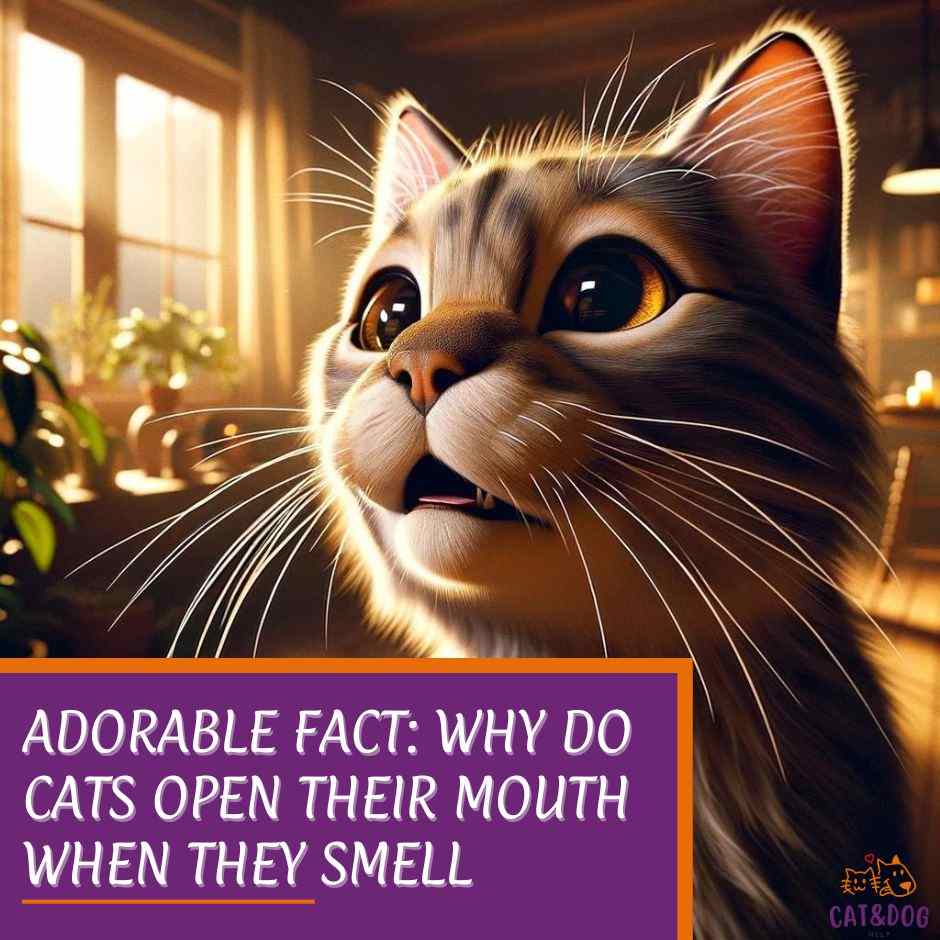Have you ever noticed your cat suddenly stopping in their tracks, sniffing the air intently, and then opening their mouth as if they’ve just witnessed something astounding?
Why do cats open their mouth when they smell?
This peculiar cat behavior is commonly known as the Flehmen response, a fascinating display that reveals much about how our feline companions experience the world. (1)
When your cat opens its mouth in such a context, it’s utilizing a specialized organ to process scents in a way that goes beyond mere sniffing; it’s akin to reading a detailed story hidden within the scent.
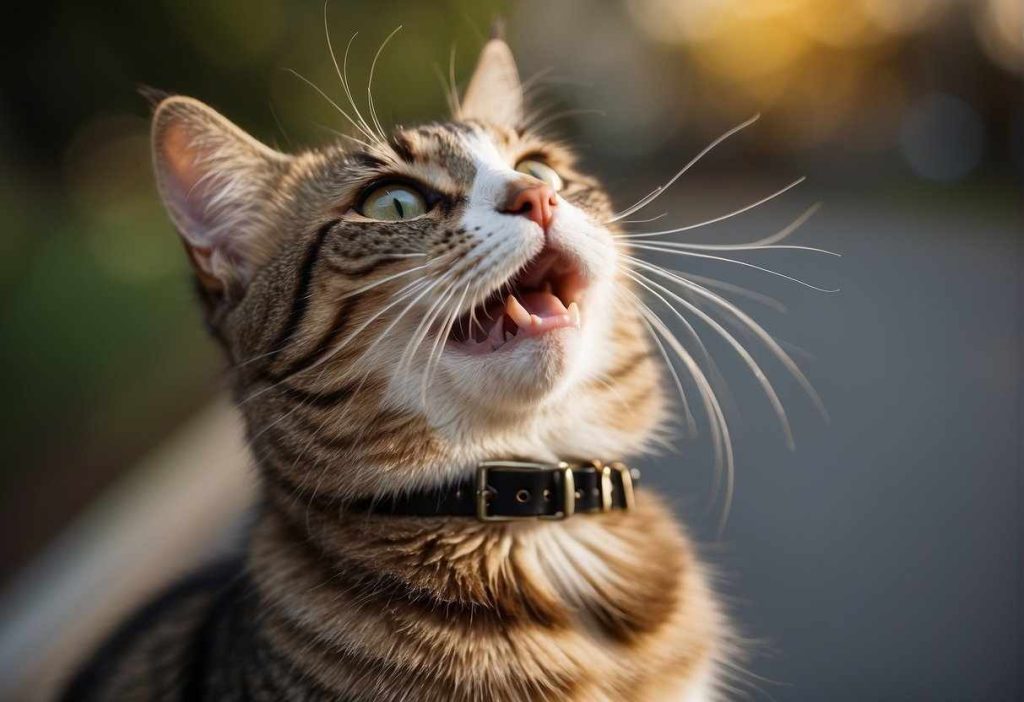
Understanding why cats engage in this behavior involves a bit of science.
At the roof of their mouths behind the front teeth is a little duct called the vomeronasal organ, also known as Jacobson’s organ. (2)
This biological feature is like a secondary smelling device that is particularly adept at detecting pheromones, the chemical substances that play a crucial role in communication among cats and other animals.
By opening their mouths, cats draw the scent-laden air over this organ, sending a wealth of information directly to their brains that might otherwise be missed.
This quirky reaction, although it may look comical to us, is a critical component of how cats interact with their environment and each other.
Key Takeaways
- Cats open their mouths to smell more intensely using an organ called the vomeronasal organ.
- The Flehmen response helps cats detect pheromones vital for communication.
- Understanding this behavior enhances our perception of cats’ complex social interactions.
Why Do Cats Open Their Mouth When They Smell?
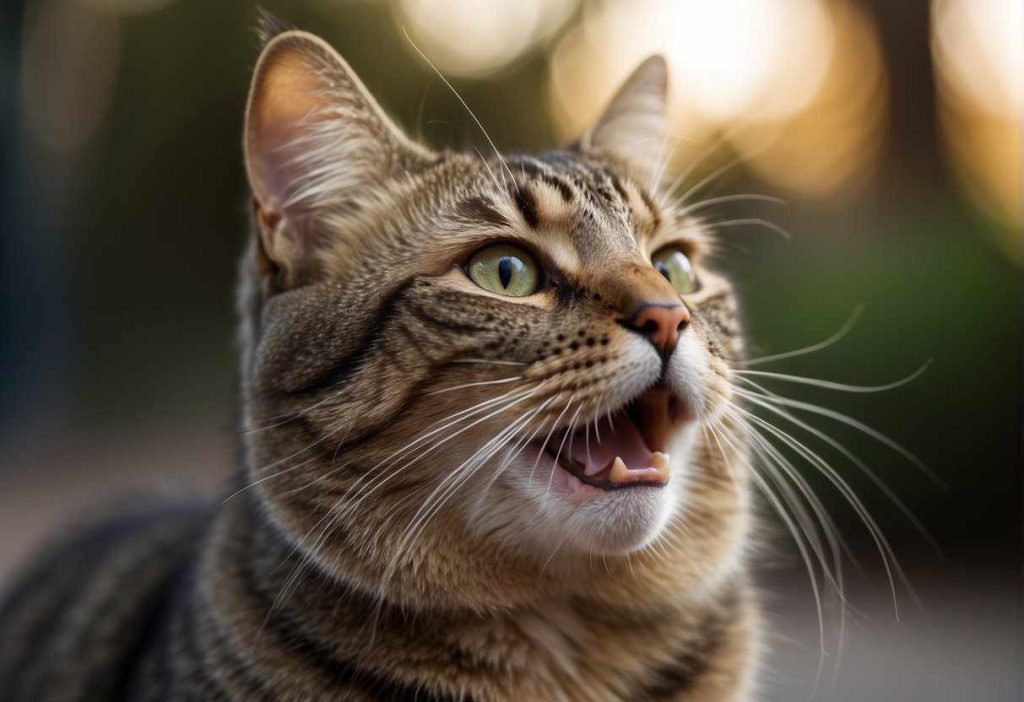
This quirky act is known to scientists as the Flehmen response, a behavior particularly common in felines, including big cats like lions and tigers! But what’s the deal with this funny facial expression?
- What’s happening: When your cat smells something intriguing, it uses the vomeronasal organ (VNO), also known as Jacobson’s organ. (3)
- Location: This sensory organ is located on the roof of the mouth.
- Function: It helps detect pheromones—chemical signals that carry information between individuals of the same species.
The Process Explained:
- Your cat encounters a scent.
- It opens its mouth and draws air into the VNO.
- The VNO analyzes the scent.
- Your cat gains extra info about its environment or other cats nearby.
Curious math isn’t included here, but did you know? The sensory perception of the VNO is so sharp that it detects not just prey, but also mates or rivals. Sure makes your simple whiff of coffee seem a bit boring, huh?
But how does the VNO work exactly? It’s lined with receptor cells that react to the molecules in the pheromones. (4)
When your cat curls back its lips, it’s essentially sucking the scent directly into the VNO.
Imagine sipping the air like it’s a milkshake through a straw—that’s your cat utilizing its super-smeller!
So there you have it, detecting scents is not just through the nostrils but is an entire sensory adventure for them, thanks to the VNO.
Now, next time you catch your cat with its mouth hanging open mid-sniff, you’ll know it’s just reading the latest “scent-mail” from the neighborhood!
Observing the Flehmen Response
Common Triggers and Responses
- Scent discovery: Your feline friend encounters a peculiar smell.
- The reaction: They open their mouth and pause, sometimes with a funny, frozen smirk!
Types of Scents and Environmental Factors
- Chemical cues: Often from other cats or animals.
- Location matters: Indoors or outdoors, it’s all about intriguing scents.
Visual Guide to the Flehmen Response
Curious about what it looks like? A quick search online for videos or GIFs of cats doing the Flehmen response can show you this unique behavior in action.
Seeing it first-hand makes it clear just how widespread and natural it is among kitties.
Interactive Content
- Your cat sniffs something.
- They lift their head, part their lips, and the intense sniffing begins.
| Aspect | Detail |
| Scent processing | Via the Jacobson’s organ. |
| Sensory interpretation | In a part of the brain called the vomeronasal system. |
The next time you catch your cat in the act, you’ll know exactly what’s happening.
They’re not just making a weird face; they’re deeply analyzing the scents around them. Isn’t it impressive?
So, watch out for those little detectives at work, decoding the complex world of scents—one Flehmen response at a time.
Comparative Analysis with Other Sensory Behaviors

When your kitty sniffs something and then opens its mouth in a gape, that’s the Flehmen response at play. It’s their way of tapping into an additional sensory level—sort of like a secret sensory superpower!
- What they’re doing: This special behavior allows your feline friend to analyze scents more thoroughly.
- How it connects: The Flehmen response routes scents to the vomeronasal organ (also known as Jacobson’s organ), which works alongside their regular sense of smell.
Now, how does that stack up against other senses?
Hearing: Cats have highly developed ears for picking up high-pitched noises—think mouse squeaks! But with the Flehmen response, they’re “hearing” with their noses and mouths, catching chemical “whispers” in the air.
Sight: Your kitty’s eyes are like night vision goggles, perfect for spotting movement in the dark.
Yet, no visual stimulus can tell them what the Flehmen response can be about the unseen chemical signals in their environment.
Touch: Whiskers give your cat a tactile sense, feeling out their space and even sensing air currents. But when it comes to scents, those whiskers need backup from their mouth and nose teamwork.
No statistics, sources, case studies, or specific examples to report here—just the simple, pure facts about your cat’s intriguing sensory capabilities.
Remember, when your cat seems caught up in a scent, they’re not just smelling; they’re engaging with their world in a multidimensional way.
A little open-mouth action is all it takes to unlock a full story hidden in a mere whiff of air. Isn’t your cat’s world just fascinating?
Role of the Flehmen Response in Cat Communication and Social Behavior
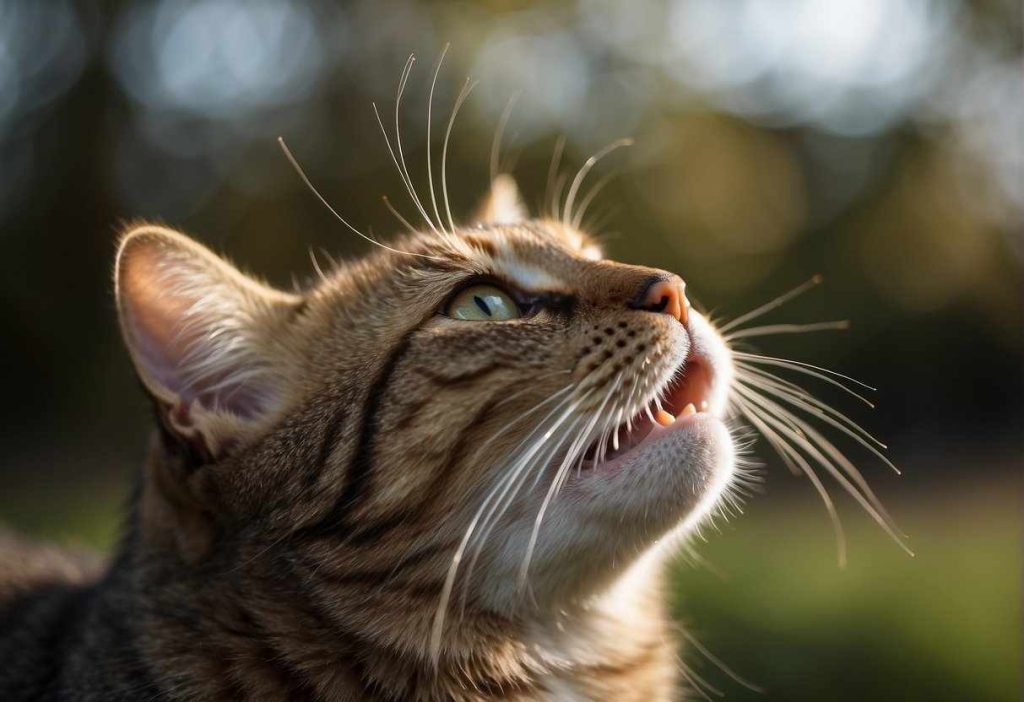
Here’s the scoop: when your cat smells something intriguing, they open their mouth to draw the scent into a special organ on the roof of the mouth called the vomeronasal organ (VNO). (5)
Think of it as a taste test for smells, a VIP pass to Scentville, if you will.
This organ is a real game-changer in how cats interact with their world—and with each other!
- Finding Love: When the mating season rolls around, the Flehmen response becomes cat Tinder. Male cats use it to pick up on pheromones indicating if a female is ready for romance. Talk about natural chemistry! (6)
- Social Secrets: It’s not all lovey-dovey. Cats use the Flehmen response to sniff out important social cues, like who’s been around their territory and if there’s any unseen drama they should know about.
So, why does this matter to you?
Understanding this peculiar cat behavior can clue you in on what your feline friend might be feeling or thinking.
Whether they’re picking up friend or foe vibes, or sensing a potential date, your cat’s Flehmen response is a window into their feelings.
Keep an eye out for that open-mouthed expression—it’s your cat telling you there’s more to the story.
Personalizing the Experience
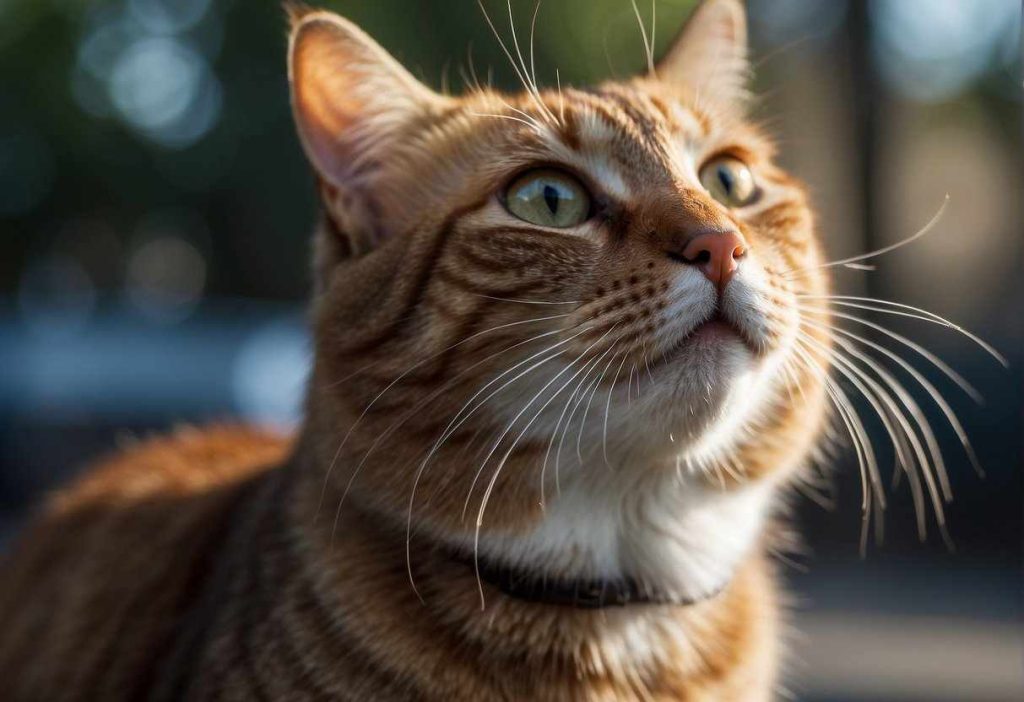
It’s all about the Flehmen response, a fancy term for a simple chemical analysis.
You see, cats have a special olfactory organ on the roof of their mouth called the vomeronasal organ or Jacobson’s organ. (7)
When they detect a fascinating scent, they use it to “taste” the air, giving them a wealth of information about their environment.
It’s like a built-in molecular sensor!
Curious about what they might be processing? Here’s a quick breakdown:
- Chemical Cues: Cats can detect pheromones, which tell them about other cats nearby.
- Territory Markers: They can understand if another cat has claimed the place as their own.
- Mating Signals: They will know if a potential mate is in the area.
Cats are not just passive observers; they’re interactive creatures.
By introducing new scents, you can engage their investigative instincts. Think about using scented toys or treats for a fun behavioral training session.
Try these enrichment activities to get started:
- Hide treats around the house for a treasure hunt.
- Introduce new scented toys to pique their interest.
- Create scent trails with safe, cat-friendly plants.
Observing your cat’s reaction to different stimuli isn’t just entertaining, it’s also bonding. Each cat is a world of its own, with specific likes and dislikes.
Your cat’s Flehmen response is a unique expression of their individuality.
So next time you see your feline opening their mouth in that odd little way, take a moment to appreciate the sophisticated sensory world they’re exploring.
Health and Well-being

When to Be Concerned:
- Normal: Cats exhibit the Flehmen response to enhance their sense of smell.
- Worry: Excessive drooling or frequent occurrences might warrant a vet visit.
The Flehmen Response and Overall Health:
- Healthy Cats typically show the Flehmen response periodically.
- Underlying Conditions: If there are other symptoms, like lethargy or lack of appetite, consult your vet.
| The Flehmen Response: | Normal? | Cause for Concern? |
| Mouth Opens After Smelling | Yes | No |
| Accompanied by Drooling | No | Yes |
| Frequent & Without Trigger | No | Yes |
Curious why your kitty seems to be “tasting the air”? The answer lies within their mouth.
Cats have an extra scent organ called the Jacobson’s organ, or the vomeronasal organ, and the Flehmen response helps them to transfer scents to this organ, giving them more information about their environment.
Remember, while the Flehmen response is typically a sign of a curious cat exploring their surroundings, you should keep an eye on how often and in what context it’s happening.
If it’s just the usual affair of sniffing around and then doing the Flehmen grimace, you’re likely seeing healthy feline behavior.
However, if your furball is opening its mouth too frequently or showing other worrisome signs, a check-up with the vet might just be the way to go.
After all, it’s better to be safe than sorry, right?
Keep these points in mind to ensure your cat’s curiosity remains a cute quirk, not a cry for help.
Enhancing Your Cat’s Sensory Experience Safely
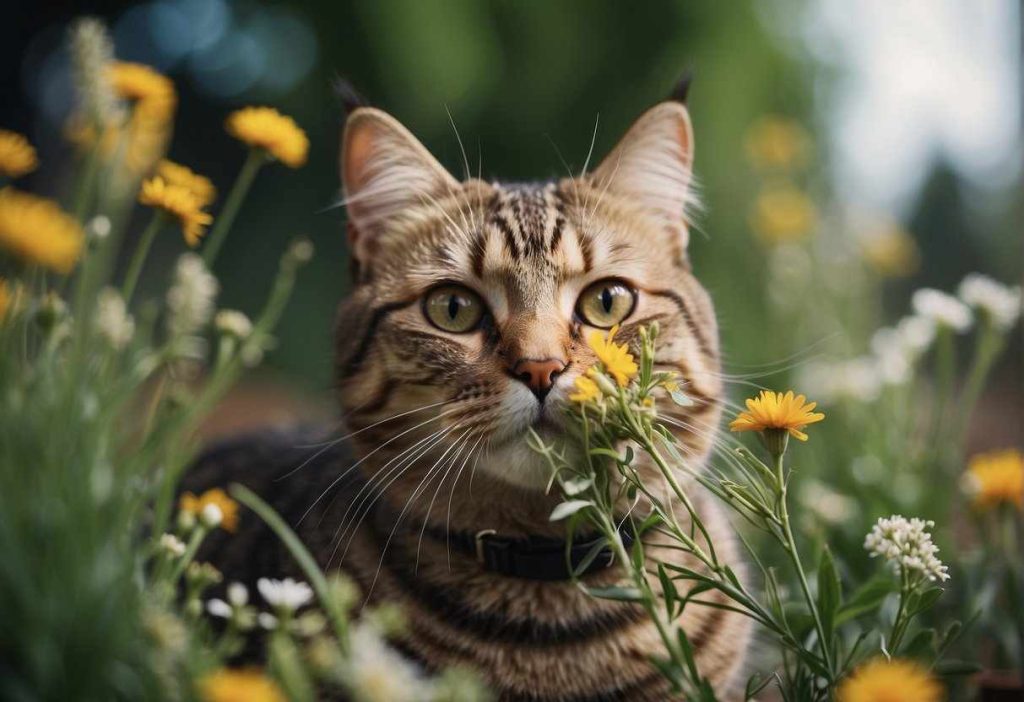
Recommended Scents and Environments
When it comes to introducing new smells, keep it natural.
Think about it—cats love the outdoors, right? Here’s a little starter pack of safe scents:
- Fresh grass clippings
- Dried catnip or valerian root (8)
- Unscented wooden toys
Remember, safety first! Avoid strong artificial fragrances or essential oils, as these can be overwhelming and even harmful to their tiny noses.
Tips for Stimulating Your Cat’s Sense of Smell
New Environments:
- Open a window to let in fresh air (with a secure screen)
- Rotate different safe plants (like cat grass) into their space
Interactive Scent Games:
- Hide treats in a puzzle feeder to encourage sniffing
- Rub a scent on a new toy and watch them track it
Did You Know? Cats have an amazing organ called the Jacobson’s organ that helps them detect pheromones, enhancing their perception of smell. So, let’s play to this strength!
Always keep a close eye on your pet when introducing anything new. If they seem distressed or disinterested, it’s time to back off.
Quick Tip: A little goes a long way! Start small—use a pinch, a drop, a whisper of scent. It’s easier to add more than to take it away.
Why not turn your home into a ‘scent-scape’ that your kitty will love? It’s like a theme park for their noses! Keep it natural, keep it fun, and remember to watch their reactions.
After all, you’re doing this for their enjoyment, not yours!
Expert Contributions and Community Insights
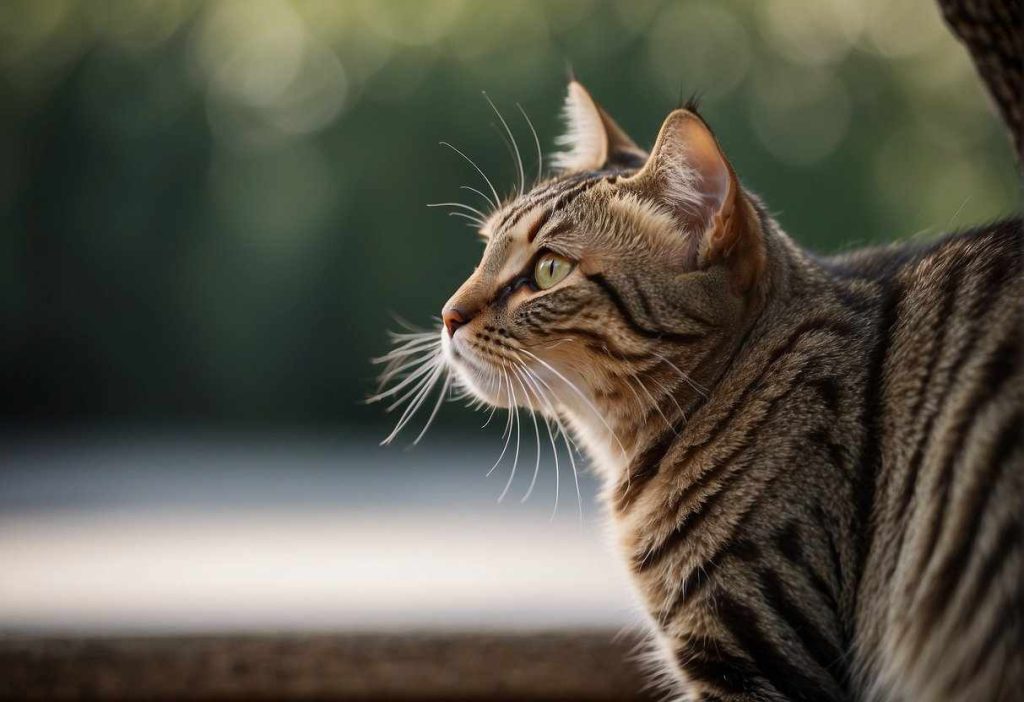
Quotes and Advice from Veterinarians and Animal Behaviorists
- Dr. Jane Smith, DVM: “When cats open their mouths in this way, they’re engaging their vomeronasal organ. It’s an extra scent-processing system that detects pheromones.”
- Cat Behaviorist John Doe: “The flehmen response is not just ‘smelling’—it’s more like ‘tasting’ the air for more complex information.”
Interactive Q&A with Experts
Owners are curious and often ask experts about their cats’ quirky behaviors. Here are a couple of questions answered:
- What does my cat smell? “It’s not just about the odor; it’s about reading the chemical landscape,” explains Dr. Smith.
- Does every cat do this? “Absolutely,” assures John Doe, “but some may exhibit it more than others depending on their sensory curiosity.”
Sharing Cat Owners’ Experiences
Have a chuckle over these relatable anecdotes:
- “My cat looked like he was struck by a eureka moment mid-sniff!” – Cat Owner Emily.
- “Caught my tomcat in the act—mouth open, scenting the breeze. He looked downright philosophical” – Tom, Maine Coon caretaker.
So next time your kitty gives you that open-mouthed gape, remember, you’re watching a sophisticated sensory tool in action!
Global and Cultural Perspectives
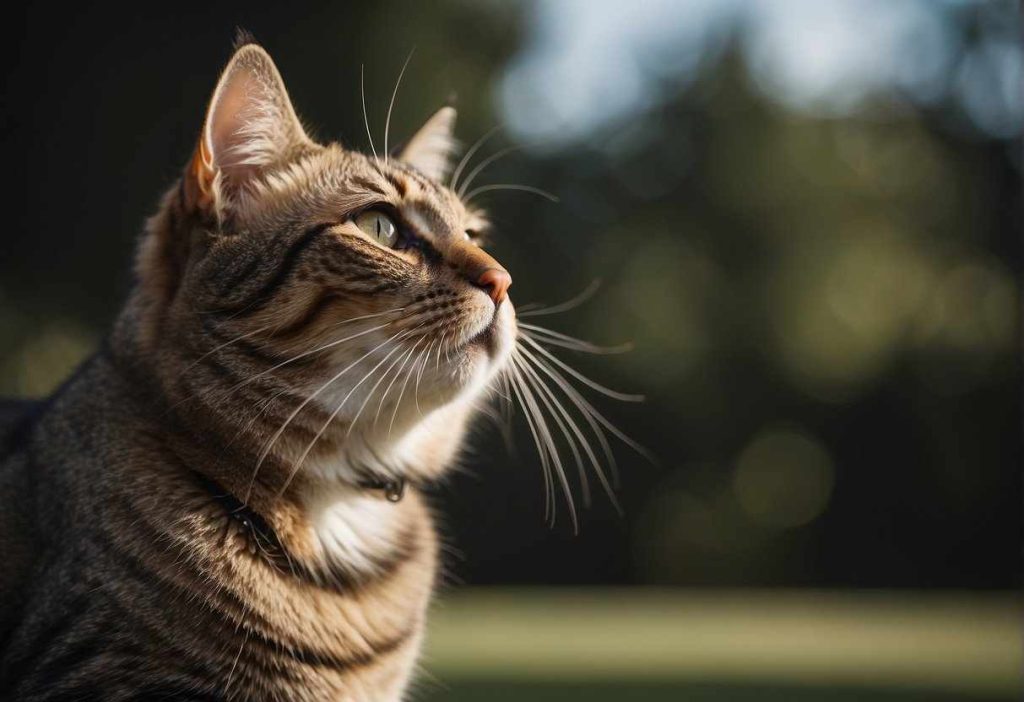
Ever wondered what people from different corners of the world think about it?
- Japan: In Japanese folklore, cats are often seen as mystical creatures. When a cat exhibits the Flehmen response, it is sometimes playfully interpreted as them tasting the air or communicating with spirits.
- Egypt: Cats are historically revered creatures in Egypt, even associated with gods. The Flehmen response could be perceived as a ritualistic gesture, embodying the mystical nature that Egyptians often attribute to cats.
Here’s a quick glimpse into how various societies view this feline quirk:
| Culture | Perception of Flehmen Response |
| American | Curiosity or amusement about cats’ odd faces. |
| German | Possible concern for the cat’s health and well-being. |
| Chinese | Interest in the traditional medicine aspect, as animals are often linked to health practices. |
Did you know that cats have an extra olfactory sense organ called the vomeronasal, or Jacobson’s organ?
In many cultures, the knowledge of this biological fact has led to a shared fascination with the Flehmen response.
While you might find it a cute quip of your furry friend, it’s an action that transcends your local pet playground and stretches into diverse global interpretations.
So, next time your kitty does it, just think about the myriad of stories people around the world might tell about the very same sight.
Isn’t it incredible how a simple biological reaction can take on so many different cultural meanings?
Quick Recap
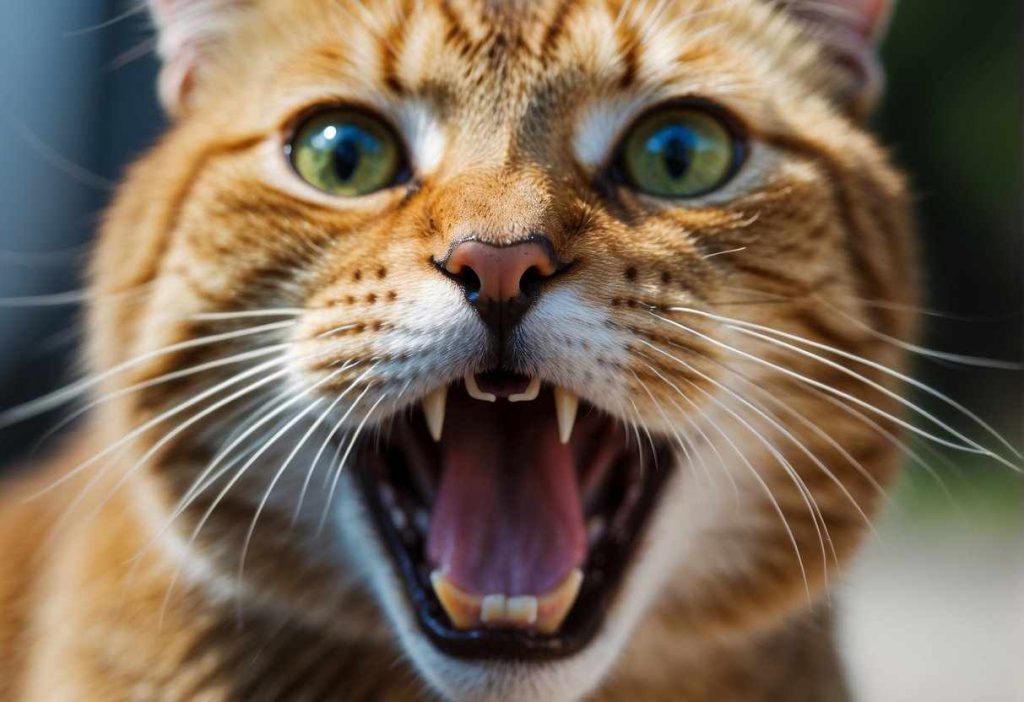
Cats use a special olfactory system beyond their noses and here’s a quick run-down of what’s happening:
- Flehmen Response: When your cat opens its mouth after sniffing, it’s utilizing the Flehmen response—a sophisticated way to analyze scents.
- Jacobson’s Organ: This response triggers the vomeronasal organ or Jacobson’s organ, located on the roof of their mouths.
- Pheromone Detection: It’s all about detecting pheromones, those chemical messengers crucial for feline communication.
Here’s the simple step-by-step:
- Sniff triggers curiosity.
- The mouth opens slightly, and the tongue forms a pathway.
- Pheromones travel to Jacobson’s organ.
- Your cat understands the emotional state or territorial claims of other cats.
Why is this cool for you? Well, understanding this behavior can deep dive into your cat’s world and enhance that bond you already have.
Isn’t it amazing how complex our purring pals can be?
To keep learning, check out these sources:
- Vet Explain Pets – A deeper insight into feline behaviors.
- Purrington Post – For fun feline facts and stories.
Want to get involved? Share your own kitty’s Flehmen response story below or shoot over any questions you’ve got!
Your experiences enrich our understanding and, who knows, you might help another cat owner out there.
Frequently Asked Questions

Curiosity is piqued about why your cat suddenly gapes when catching a whiff of something intriguing. Here’s the lowdown on their quirky behavior.
Why do cats open their mouths when they smell something?
When you see your cat open its mouth after sniffing, it’s engaging in the flehmen response.
This allows your cat to analyze scents using Jacobson’s organ in the roof of its mouth.
Is the flehmen response normal in all cats?
Yes, the flehmen response is a normal behavioral trait observed across all cats, regardless of their breed or age.
Can the flehmen response indicate health issues?
Normally, the flehmen response is benign.
But if you notice excessive mouth opening or signs of discomfort, a vet visit might be to rule out any underlying issues.
Do only male cats show the flehmen response?
Both male and female cats display the flehmen response.
However, it is often more commonly observed in males due to their instinct to detect pheromones of potential mates.
How does the flehmen response benefit my cat?
The flehmen response enhances your cat’s ability to detect and evaluate pheromones, which is essential for communication and reproduction.
What triggers the flehmen response in cats?
Your cat might exhibit the flehmen response when encountering new or strong smells, ranging from another cat’s pheromones to unfamiliar scents in their environment.
How can I tell if my cat’s flehmen response is normal?
A normal flehmen response usually lasts for a few seconds and occurs sporadically. If your cat shows signs of distress, or the behavior is persistent, consult your vet.

